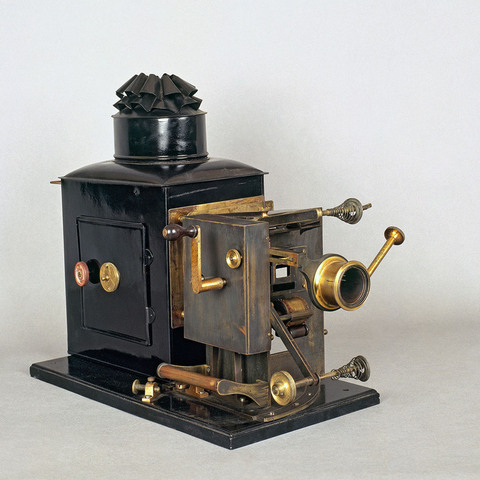Projecteur de film 35 mm et plaques de verre
Fiche détaillée
Type de l'appareil
entraînement du film 35 mm par roue à cliquet ; un débiteur denté ; obturateur à boisseau ; couloir velours avec presseur ; projecteur monté sur glissière ; lanterne en tôle russe avec cheminée ; objectif à crémaillère ; condensateur ; passe-vue ; emplacement pour cuve à eau ; manivelle ; base en métal peint
Auteurs
Informations non disponibles
Fabricants
Alfred Wrench
Londres, 50 Gray's Inn Road
John and Sons Wrench
Londres, 50 Gray's Inn Road
Utilisateurs
Informations non disponibles
Distributeurs
John and Sons Wrench
Londres, 50 Gray's Inn Road
Alfred Wrench
Londres, 50 Gray's Inn Road
Sujet du modèle
Informations non disponibles
Objectif
4 cm Ø
Taille de l'objet
Ouvert :
Informations non disponibles
Fermé :
Longueur : 52.5 cm
Largeur : 26 cm
Hauteur : 44.5 cm
Diamètre :
Informations non disponibles
Taille de la boîte de transport
Informations non disponibles
Remarques
Le projecteur de film pivote sur lui-même pour laisser place à l'objectif réservé à la projection fixe.
"134. One Wrench Projector with mechanism and lamp house complete, being the first model to be sold by this firm fitted with an automatic film rewind attachment and a swing front to shift from still to moving pictures. 1899." (Will Day, Illustrated Catalogue of the Will Day Historical Collection, Londres, s.d., [1934], p. 21).
"Wrench's improved cinematographs. A greatly improved pattern of cinematograph, termed n° 100 B, has been placed before the trade by Messrs. Wrench & Son. The body of the lantern is of Russian iron mounted upon a substantial cast iron stand, the top of which is accurately planned. With both lantern and cinematograph metal has been used in every fitting, the only piece of wood which is to be found on it being the small handle of the door. This cinematograph is so pivoted on its base that it is made to swing round on a brass quadrant, so that an ordinary projection lens with which it is fitted can readily be brought into use for either the projection of title or ordinary slides. The workmanship throughtout is simply beautiful and the fittings absolutely accurate. The alum trough is so fitted to the cinematograph that it is swung out of the heat rays simultaneously with the cinematographic portion. The spools for the film are of 4 7/8 diameter, thus affording ample accommodation for about 200 feet of film. The projection lens for the film pictures is also fitted on a rough adjustement slide, thus facilitating the employment of lenses of varied foci. The action of the entire instrument is very certain, accurate, and smooth, and the film is automatically wound up on the lower spool immediately after passing the condenser. Another new, and we may say superfine, instrument termed One turn one picture is also being made. The instrument has a double feed spocket which permits of any lenght of film being used without the slightest strain upon it" (Optical Magic Lantern Journal, Vol.9, n° 11, octobre 1898, p. 154).
Bibliographie
Optical Magic Lantern Journal, Vol.9, n° 11, octobre 1898, p. 154.
J. Barnes, Pioneers of the British Film, Londres, 1983, pp. 124-125.
Will Day, Illustrated Catalogue of the Will Day Historical Collection, Londres, s.d., [1934], p. 21.
